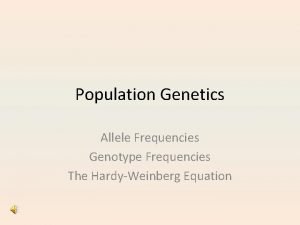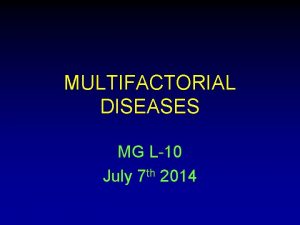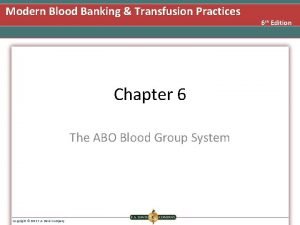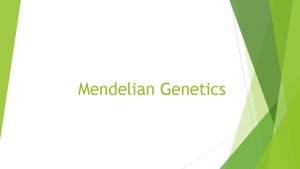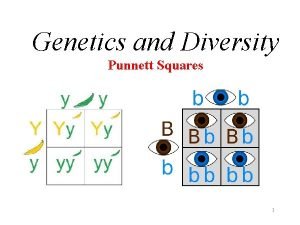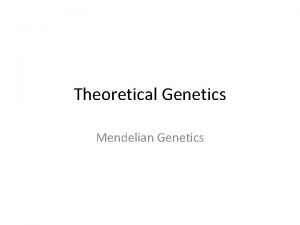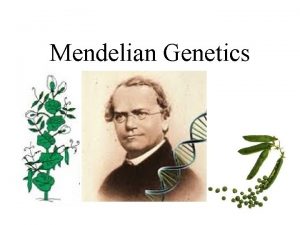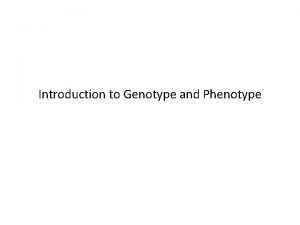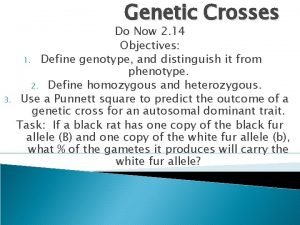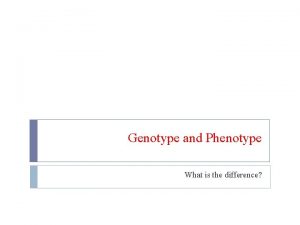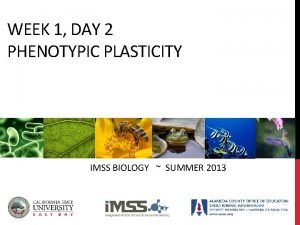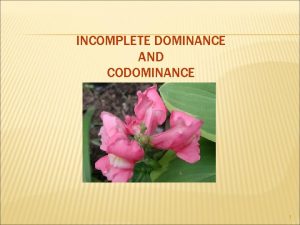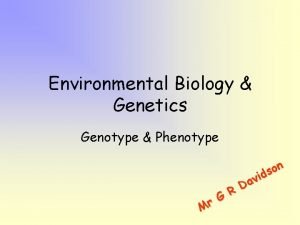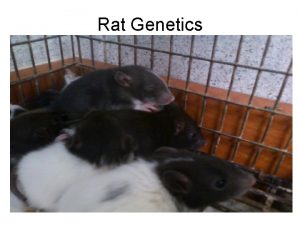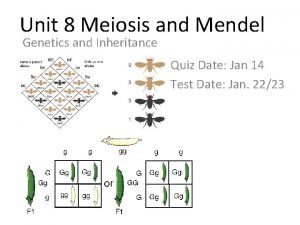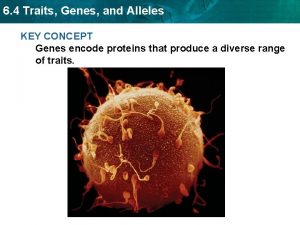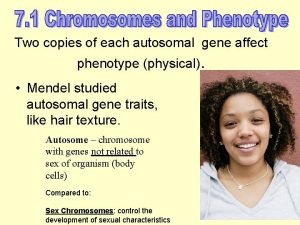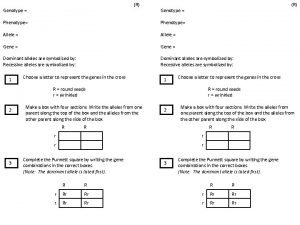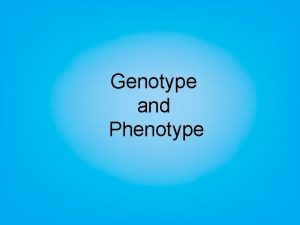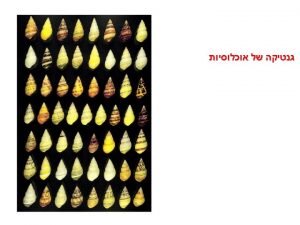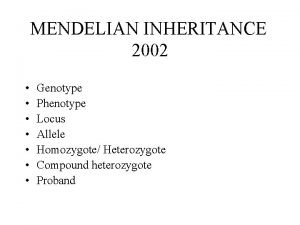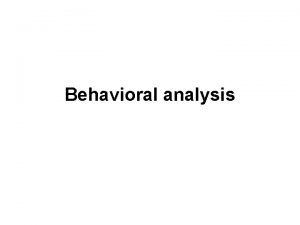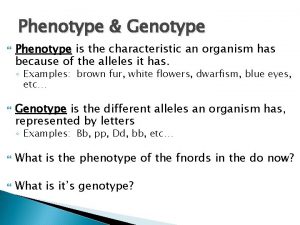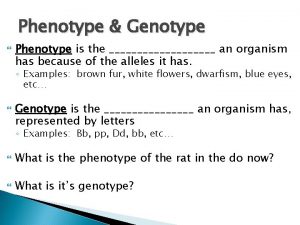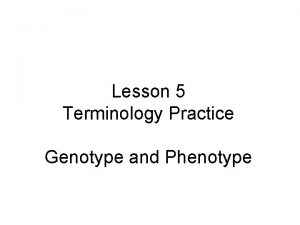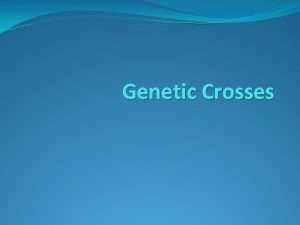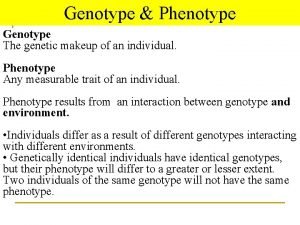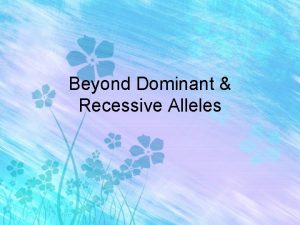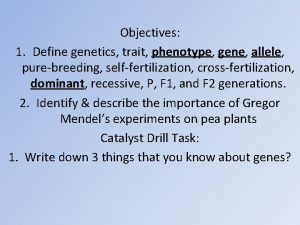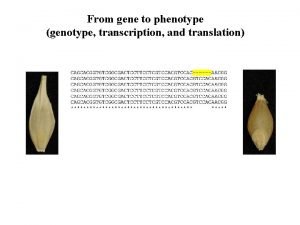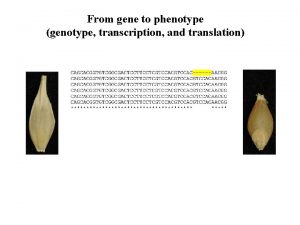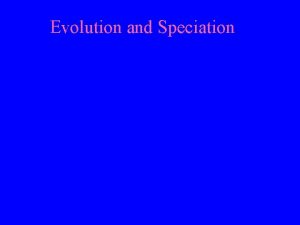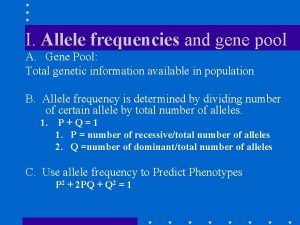Warm Up 6 34 Phenotype allele Gene genotype
























- Slides: 24

Warm Up 6 3/4 Phenotype allele Gene genotype 1. Chemical factors that determine traits 2. Different forms of a trait 3. Visible trait 4. Genetic makeup 5. What did Mendel discover? 6. What did Darwin discover? Slide 1 of 24 End Show

Darwin was at a disadvantage when developing theory of evolution due to his lack of understanding of how genes worked. He could not explain • The source of variation • How inheritable traits were passed from one generation to the next Ch. 16 Evolution of Populations Slide 2 of 24 End Show

Slide 3 of 24 End Show

16 -1 Genes and Variation Gene combinations & variations in traits can lead to evolution of species. Slide 4 of 24 Copyright Pearson Prentice Hall End Show

I. Variation and Gene Pools a. gene pool b. relative frequency II. Sources of Genetic Variation a. mutations b. gene shuffling III. Single-Gene and Polygenic Traits Slide 5 of 24 Copyright Pearson Prentice Hall End Show

16 -1 Genes and Variation How Common Is Genetic Variation? Many genes have at least two forms, or alleles. All organisms have genetic variation that is “invisible” because it involves small differences in biochemical processes. An individual organism is heterozygous for many genes. Slide 6 of 24 Copyright Pearson Prentice Hall End Show

16 -1 Genes and Variation and Gene Pools I. Variation and Gene Pools • Studied by populations. • A population is a group of individuals of the same species that interbreed. Slide 7 of 24 Copyright Pearson Prentice Hall End Show

16 -1 Genes and Variation A. gene pool- all genes (& alleles) in a population. Slide 8 of 24 Copyright Pearson Prentice Hall End Show

16 -1 Genes and Variation and Gene Pools B. Relative frequency- how often alleles shows up in gene pool • % • Not related to whether an allele is dominant or recessive Slide 9 of 24 End Show

16 -1 Genes and Variation and Gene Pools Gene Pool for Fur Color in Mice Sample Population Frequency of Alleles allele for brown fur allele for black fur Slide 10 of 24 Copyright Pearson Prentice Hall End Show

16 -1 Genes and Variation and Gene Pools Evolution is any change in the relative frequency of alleles in a population. Slide 11 of 24 Copyright Pearson Prentice Hall End Show

16 -1 Genes and Variation Sources of Genetic Variation II. Sources of Genetic Variation The two main sources of genetic variation are 1. Mutations 2. genetic shuffling that results from sexual reproduction. Slide 12 of 24 Copyright Pearson Prentice Hall End Show

16 -1 Genes and Variation Sources of Genetic Variation A. Mutations A mutation is any change in a sequence of DNA. Mutations occur because of mistakes in DNA replication or as a result of radiation or chemicals in the environment. Mutations do not always affect an organism’s phenotype. Slide 13 of 24 Copyright Pearson Prentice Hall End Show

16 -1 Genes and Variation Sources of Genetic Variation B. Gene Shuffling- occurs during gamete formation • Most heritable differences are due to gene shuffling. • Crossing-over exchange of genetic material • 23 chromosomes produce 8. 4 million different combinations Copyright Pearson Prentice Hall Slide 14 of 24 End Show

16 -1 Genes and Variation Crossing-Over Slide 15 of 24 End Show

16 -1 Genes and Variation What are 2 main sources of genetic variation? Slide 16 of 24 Copyright Pearson Prentice Hall End Show

16 -1 Genes and Variation Single-Gene and Polygenic Traits III. Single-Gene and Polygenic Traits The number of phenotypes produced for a given trait depends on how many genes control the trait. Slide 17 of 24 End Show

16 -1 Genes and Variation Single-Gene and Polygenic Traits A. Single-gene trait-controlled by one gene -2 phenotypes Slide 18 of 24 Copyright Pearson Prentice Hall End Show

16 -1 Genes and Variation Single-Gene and Polygenic Trait B. Polygenic traits- controlled by 2 or more genes. -Many phenotypes -Height in humans -Bell shaped curve Slide 19 of 24 Copyright Pearson Prentice Hall End Show

16 -1 Which of the following statements is TRUE? a. The relative frequency of an allele is not related to whether the allele is dominant or recessive. b. Mutations always affect an organism's phenotype. c. Crossing over decreases the number of different genotypes that appear in an offspring. d. Evolution does not affect the frequency of genes in a gene pool. Slide 20 of 24 End Show Copyright Pearson Prentice Hall

16 -1 Most inheritable differences are a result of a. gene shuffling. b. frequency of alleles. c. mutations. d. DNA replication. Slide 21 of 24 End Show Copyright Pearson Prentice Hall

16 -1 The main sources of inherited variation are a. gene shuffling and mutations. b. gene pools and frequencies. c. single-gene and polygenic traits. d. genotypes and phenotypes. Slide 22 of 24 End Show Copyright Pearson Prentice Hall

16 -1 A widow's peak in humans is an example of a(an) a. invariable trait. b. single-gene trait. c. polygenic trait. d. mutation. Slide 23 of 24 End Show Copyright Pearson Prentice Hall

16 -1 A graph of the length of the little finger on the left hand versus the number of people having fingers of a particular length is a bell-shaped curve. This indicates that finger length is a a. single-gene trait. b. polygenic trait. c. randomly inherited trait. d. strongly selected trait. Slide 24 of 24 End Show Copyright Pearson Prentice Hall
 Allelic and genotypic frequencies
Allelic and genotypic frequencies How to calculate allele frequency from genotype
How to calculate allele frequency from genotype Difference between monohybrid and dihybrid crosses
Difference between monohybrid and dihybrid crosses Abo phenotype and genotype
Abo phenotype and genotype Widows peak
Widows peak Blue eyes phenotype
Blue eyes phenotype Mendel
Mendel Genotypic ratio of monohybrid cross
Genotypic ratio of monohybrid cross Applying mendels principles
Applying mendels principles Phenotype and genotype
Phenotype and genotype Genotype
Genotype Genotype and phenotype
Genotype and phenotype Homozygous and heterozygous
Homozygous and heterozygous Ttxtt punnett square
Ttxtt punnett square Phenotype, genotype
Phenotype, genotype Phenotypic ratio in dihybrid cross
Phenotypic ratio in dihybrid cross What is a genotype and phenotype
What is a genotype and phenotype Phenotype and genotype
Phenotype and genotype Punnet squares
Punnet squares Rat with black hair
Rat with black hair Phenotype and genotype
Phenotype and genotype Genotype ratio
Genotype ratio Allele vs gene
Allele vs gene Allele vs gene
Allele vs gene Two copies of each autosomal gene affect phenotype
Two copies of each autosomal gene affect phenotype
